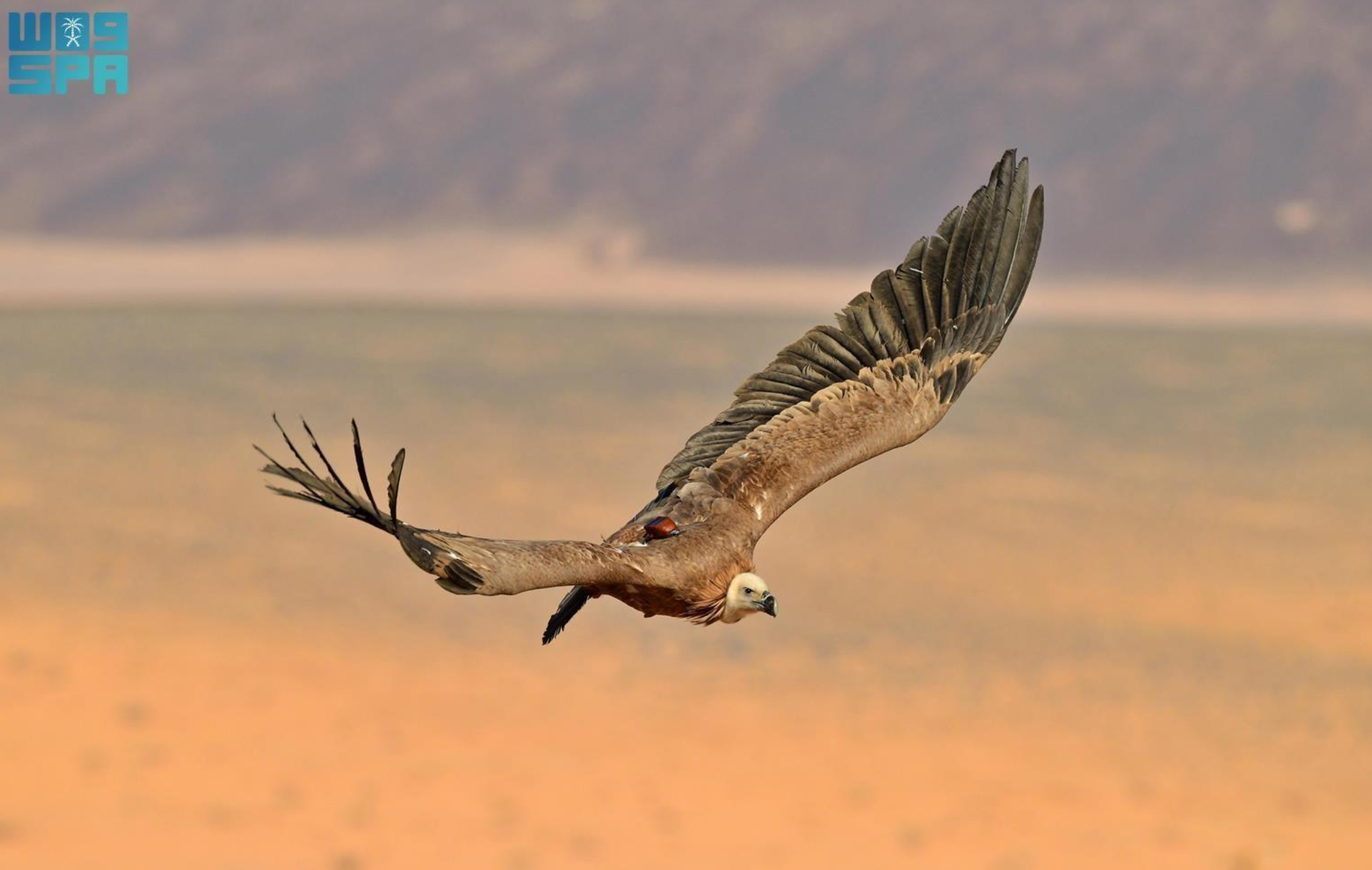
Two Eurasian Griffon Vultures Tagged by Prince Mohammed bin Salman Royal Reserve Travel over 245,000 km across Eight Countries
Two endangered Eurasian griffon vultures, tagged with satellite trackers by the Prince Mohammed bin Salman Royal Reserve, have traveled a remarkable 245,632 kilometers across eight countries over the past 29 months. Released in conjunction with International Vulture Awareness Day, this unprecedented real-time data underscores the global conservation crisis facing vultures and highlights the critical need for cross-border cooperation to ensure their survival.
The first vulture, released on April 3, 2023, has journeyed 119,499 km to date. Its remarkable flight path began from the reserve in northwestern Saudi Arabia and took it through Jordan, Syria, Iraq, Turkiye, Armenia, Azerbaijan, and Iran. During the winter of 2023, the vulture returned to southwestern Saudi Arabia, passing through the reserve once more. In the spring of 2024, it migrated north again and has since remained in the mountains of Armenia and Azerbaijan. The data collected shows it has reached altitudes of 6,527 meters, speeds of 123 km/h, and experienced air temperatures ranging from 9°C to 54°C.
The second vulture, also released on April 3, 2023, has flown 126,133 km so far. Its journey took it from the reserve to Iraq, where it reached an astounding maximum altitude of 9,029 meters—three times higher than a light aircraft—and a top speed of 128 km/h. It eventually settled in the Lesser Caucasus Mountains, spanning parts of Turkiye and Iran, after traversing Saudi Arabia, Jordan, Iraq, and Turkiye.
Individual Eurasian griffon vultures, even from the same population, exhibit different behaviors, with some migrating long distances while others remain resident. This finding highlights the need for diverse management strategies.
Prince Mohammed bin Salman Royal Reserve CEO Andrew Zaloumis said: "This tracking data represents the first comprehensive study of Eurasian griffon vulture movements in Saudi Arabia and beyond, providing real-time baseline information that was previously unavailable to conservationists."
He added: "The data reveals these birds have traveled the equivalent of six circumnavigations around the Earth in less than 2.5 years — an incredible distance that underscores the opportunity and urgent need for regional conservation strategies to ensure their long-term survival. At a time when the IUCN is reporting that 16 of the world’s 23 vulture species are at risk of extinction, migratory bird populations must be managed as meta-populations across borders if we are to secure their future."
Prince Mohammed bin Salman Royal Reserve, in collaboration with the National Centre for Wildlife, rehabilitated and rewilded the two rescued Eurasian griffon vultures in April 2023 and has been recording their movements ever since. The 24,500 square kilometer terrestrial and marine reserve was chosen for the release due to its ideal habitat for nesting and roosting.
The Reserve fitted solar-powered satellite transmitters to both birds to monitor their dispersal and migration patterns following release. This technology will continue to provide valuable data for approximately three years, at which point the Teflon tape holding the transmitters will naturally decompose.
The birds were tagged as part of the reserve’s ongoing efforts to understand the movements of large migratory species, a field where little information exists for Saudi Arabia. The satellite tags are providing crucial, real-time data on migration routes, habitat utilization, critical stopover points, and congregation areas. This information is vital for filling key knowledge gaps about the movements of vultures both within the reserve and across the broader region.
Vultures are facing a severe global conservation crisis, with all species now classified as threatened on the regional IUCN Red List. Often misunderstood, these birds play a vital role in maintaining healthy ecosystems and preventing the spread of diseases by acting as nature's "clean-up crew." Highly susceptible to poisoning, both intentional and accidental, vultures are also under threat from habitat loss, illegal poaching for trade, and electrocution from power lines.
Based on this data, the reserve can now inform and implement more effective management strategies. The tagged vultures provided critical information on the presence of both resident and migratory populations, which has allowed the reserve to focus its monitoring efforts on specific, targeted locations.
This insight has enabled the reserve to monitor the habitats of both tagged and untagged vulture populations, and these areas are now afforded the highest level of protection under the reserve's zonation plan. The success of these conservation efforts was further highlighted in September 2024 with the discovery of four active Eurasian griffon vulture nests across three separate breeding colonies, a testament to the reserve's conservation work and its vital role as a sanctuary for the Kingdom's natural heritage.
The reserve is dedicated to sharing its findings with the local and global scientific and conservation community. To date, it has published eight peer-reviewed papers, with five more currently being drafted.
This research is particularly significant given Saudi Arabia's commitment to the Convention on Migratory Species (CMS), an agreement among 133 countries that promotes the conservation of migratory animals and their habitats across national borders. The CMS currently registers over 150 species, including griffon vultures.
The new data gathered by the reserve is poised to have a major global impact. It can aid research to secure and support migratory species by contributing to species-specific action plans, working groups, and regional assessments. Additionally, through collaboration with global organizations like BirdLife International, this information can help in the establishment of Important Bird Areas or Protected Areas, and inform conservation strategies with other royal reserves and regional partners.








